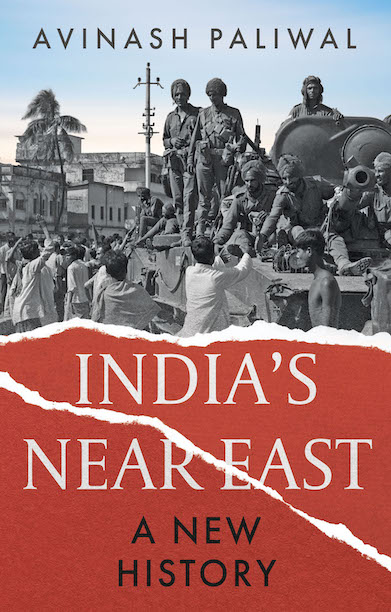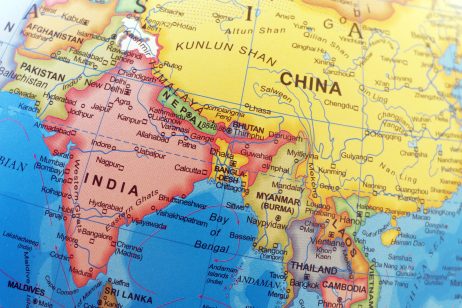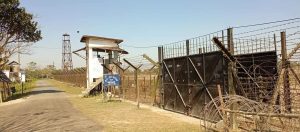India’s decades-old “Look East” and “Act East” policies, which are aimed at spurring development in India’s northeastern states via connectivity through Myanmar and Bangladesh, have failed to make much headway. In his book “India’s Near East: A New History” (Penguin-Random House, 2024), author Avinash Paliwal says that India adopted a variety of strategies to expand its influence in its near east. “From promoting democracy to bolstering authoritarians, arming rebels to waging wars, building ports to granting loans, India has experimented with multiple ideas … with limited success,” he writes. Indeed, several connectivity projects remain incomplete and India’s relations with Bangladesh and Myanmar are unstable and have deteriorated significantly. Its influence in its near east has waned substantially.
Examining the reasons for India’s failure to improve connectivity with its near east, Paliwal, a scholar in the international relations of South Asia, told The Diplomat’s South Asia editor Sudha Ramachandran that in addition to “bureaucratic delays” in implementing projects, and unrest, insurgencies and civil conflict in the region, the surge of Hindu nationalism in India and India’s prioritization of security over free movement of people and goods have “complicated relations” and resulted in “harder borders,” “leading to social and political friction” with its neighbors to its near east. Consequently, “India’s near east is less connected in 2024 than it was in 1947,” Paliwal points out.
Despite India’s “Look East” and “Act East” policies and its efforts to build relationships and influence in Bangladesh and Myanmar with a view to improving connectivity, you have said in your book that “India’s near east is less connected in 2024 than it was in 1947.” Why did India’s efforts fail to achieve success?
There is a structural tension in New Delhi’s approach towards its near east. India desires better economic connectivity with Bangladesh and Myanmar to develop India’s far eastern states. But it also wants to limit, or heavily regulate, the movement of people. The desire for better trade and commercial ties lubricated by cross-border rail, road, and port infrastructure is central to India’s “Look East” and, as now termed, “Act East” policies. In fact, India has been trying to improve such connectivity since 1968 with limited success.
Herein, India’s national security anxieties and identity politics in Assam and other northeastern states become important. Concerned that free cross-border movement will enable anti-state rebels, drug traffickers, and other criminal actors, India’s security forces have long been wary of open borders. Similarly, real and perceived concerns about “illegal” Bengali Muslim migrants from Bangladesh have long animated the politics of Assam. This structural tension emerged during the partition of the subcontinent in 1947.
Even when India succeeded in improving connectivity, the skewed balance of trade created second-order effects. During former Bangladesh Prime Minister Sheikh Hasina’s regime (2009-24), New Delhi rebuilt several railway lines that were destroyed during the 1965 India-Pakistan war. Bilateral trade reached almost $16 billion by 2023. But Indian exports to Bangladesh comprised $14 billion. The resulting trade deficit for Bangladesh, which is a readymade garment exports and remittance-driven economy, created political ricochets. These are being felt now after the change of guard in Dhaka.
With Myanmar, big-ticket projects such as the India-Myanmar-Thailand trilateral highway remain unfulfilled. The Free-Movement Regime (FMR), critical for ease of business for communities straddling the India-Myanmar borderlands, has been scrapped since Manipur’s implosion in 2023. The Kaladan Multimodal project that seeks to connect the Sittwe port in Rakhine to Mizoram by road also remains incomplete.
To be clear, external causes beyond India’s control have posed a significant hindrance too. Political instability in Bangladesh and entrenched civil conflict in Myanmar are unfortunate realities New Delhi has had to contend with. But even when the situation in Bangladesh and Myanmar was stable, cross-border connectivity remained suboptimal. Projects that received political clearance did not make headway due to bureaucratic delays or security concerns. This is why India’s near east is less connected in 2024 than it was in 1947.

You wrote that “India’s investment in response to the Chinese presence in Bangladesh and Myanmar… underscores the limits of India’s geoeconomic power.” Could you elaborate?
India’s economic investment in its near east pales in comparison to that of China. But this is not a shortcoming. For starters, China is a much larger economy than India and is open to investing in high-risk projects with low prospects of immediate return. The China-Pakistan Economic Corridor and the China-Myanmar Economic Corridor, both part of the larger Belt and Road Initiative, are cases in point. Beijing is struggling to realize financial profits and strategic benefits in both. India cannot, has not, and arguably should not, try to outmatch China dollar-for-dollar. Such a dollar-for-dollar strategy risks straining India’s exchequer with little accruing returns.
The stress China’s growing financial influence is causing India is geopolitical in nature. China, for instance, has considerable leverage over both the junta in Naypyidaw and Myanmar’s resistance forces. Beijing struggles to translate such leverage into brokering lasting peace. But it has created strategic effects by enabling the Three Brotherhood Alliance against the junta in the north. These dynamics impact India’s national security, as seen in Manipur, and complicate its connectivity story, as seen in the lack of progress on the Kaladan Multimodal project. New Delhi has no credible levers that will afford it some conflict-shaping power in Myanmar, tactical engagements with select resistance outfits notwithstanding.
In Bangladesh, China is the key supplier of defense equipment and surveillance technology. But ingress in Bangladesh’s security-sensitive sectors has not given China a political edge in Dhaka. Thanks to geography, history, and societal linkages, India enjoys considerably higher leverage in Dhaka than Beijing and Islamabad. But as the recent weeks since the fall of Sheikh Hasina’s regime show, India is deeply and widely unpopular in Bangladesh for that very reason. New Delhi’s struggle to build bipartisan support in Bangladesh i.e., both within the Awami League (AL) and the Bangladesh Nationalist Party (BNP), is its Achilles heel. It gives China and Pakistan a lot more space to operate than their financial or religious investments in the Jamaat-e-Islami and other radical outfits merit.
India’s prioritization of its security interests in dealing with its neighbors appears to have, in fact, undermined its interests. Could you explain in the context of Myanmar?
India’s decision to scrap the FMR is a classic case in point. It was introduced to enable better cross-border economic and social connectivity for communities straddling the India-Myanmar borderlands and was central to the “Act East” policy. But free movement meant that criminal actors and militants were able to move freely too. The recent civil strife in Manipur brought this contradiction between national security and economic prosperity to the fore. It led to the strengthening of those advocating for a harder border. There are even suggestions for fencing the India-Myanmar border. Instead of resolving anything, such fencing is likely to create further social and political friction.
How has India’s domestic politics, especially communal politics, contributed to undermining its ties with Bangladesh?
India’s relations with Bangladesh and Pakistan are strongly conditioned by communalism. As the book shows, religious violence has deeply impacted India’s near east historically. Over the last decade, India’s lurch towards Hindu nationalism has complicated relations with Bangladesh. This was not as visible till Sheikh Hasina was in power. She kept anti-India public sentiment under coercive check and did not raise diplomatic protests. Her political dependency on India was, and remains, extreme. But under the surface, public anger was bubbling.
From then president of the Bharatiya Janata Party and now Home Minister Amit Shah calling Bangladeshi migrants “termites,” to the passing of the Citizenship Amendments Act (2020) that cast a shadow on the situation of Bangladeshi Hindus, the real politics — if not realpolitik — of India’s relations with Bangladesh were shaped by communalism. The outcome is for all to see. The interim government in Dhaka is a lot less compromising on these issues and has begun to challenge India in ways old and new. But to be fair, communal politics is not just an Indian preserve. Islamist politics and anti-India populism are hard-wired in Bangladesh’s body politic. These aspects often couple up with India’s own political extremes to stymie progress in this bilateral.

In 2009, when the Bangladesh Rifles mutinied, “India almost intervened militarily in Bangladesh on 27 February,” primarily in support of Sheikh Hasina and in response to her call to India for help. How similar or different was the situation in August 2024?
The key aspect to remember is that the 2009 Bangladesh Rifles (BDR) mutiny was primarily an intra-army affair, whereas the 2024 protests were a larger student-led uprising.
The risk in 2009 was that a mutiny by soldiers could have burgeoned into something bigger and undermined the viability of Prime Minister Sheikh Hasina’s newly elected government. The army officers wanted to quell the mutiny using force. But New Delhi was concerned that if force was used without Hasina’s clearance and leadership, it would undermine her authority.
Herein, it must be noted that the 2008 elections that brought Hasina to power were free and fair. They had occurred after a two-year hiatus of a military-led caretaker government. So, in a sense, India’s threat to intervene in 2009 was meant to maintain Bangladesh’s democratic integrity as much as protect an ally in Hasina. This does raise an interesting counterfactual though. Would India have threatened military intervention had the BNP been in power? Maybe not, given India’s tormented ties with Dhaka during the 2001-06 BNP government. But we would never know.
By July 2024, Hasina had lost all legitimacy. She had been forcibly in power for 15 years, rigged two elections, killed or jailed most dissidents, and commanded an empire of corruption. Such was her thirst for power that she ended up wrecking her biggest success i.e., to pull Bangladesh out of poverty and give macro-economic wings to its economy. Today, the Bangladeshi economy is teetering on the brink, and the macro-economic “miracle” has turned out to be a nightmare for Bangladeshis who never got to taste its fruits because most profits went to a small coterie.
India’s support for such an authoritarian system, and for Hasina — who was feared by most Bangladeshis — meant that it is now bearing the costs of her errors and excesses. Unsurprisingly, there was no military intervention on offer by India this time. But New Delhi did what it could to support an old ally by allowing Hasina to stay in India, where she still is.
You draw attention to India’s efforts to reach out to BNP regimes in the early 1990s and 2000s, but these made no headway in weakening the party’s anti-India tendency. Is the BNP of 2024 any different?
Being out of power for nearly two decades has impacted the BNP. But it has not altered all structural features of the party.
Let’s look at the changes first. The BNP leadership today is a lot more aware of their own limitations and shortcomings. There is an acknowledgment at the top that the party is ascendant because of the students, not because they succeeded in ousting Hasina. The other realization is that the BNP cannot continue to ally with the Jamaat-e-Islami (JI). Given the difficulty of being an AL supporter in post-August 5 Bangladesh, the JI is likely to become the main opposition party in future if the BNP comes to power (whenever elections are held). This break from the JI is driven both by strategic electoral compulsions and ideological changes. The BNP wants to be, and wants to be seen as being, a secular political party that respects minority rights and appeals to the syncretic aspects of Bangladeshi and Bengali culture.
But some troubling similarities remain. The BNP continues to be dominated by a single family i.e. Khaleda Zia and her son Tarique Zia Rahman. To be sure, dynastic politics is a norm in the subcontinent. But it also limits the potential for serious intra-party change. The AL, for instance, was condemned to its current fate because Hasina’s authoritarianism severely damaged the party’s internal discipline, structures, and processes of accountability. The BNP faces similar risks, and one can only hope that they learn from the AL’s mistakes. After all, the BNP did demonstrate street mobilization capability in the lead-up to the January 2024 elections. That this occurred despite its leaders being in self-imposed exile (Tarique Rahman) or unwell (Khaleda Zia), shows that the party retains some organizational cohesion and discipline.
There are limits to such cohesion and discipline. The last few weeks have shown that the BNP’s command and control has come under stress thanks to the post-August 5 euphoria within the party. The party leadership’s message of restraint to its cadre and guidance to protect Hindu minorities was not uniformly met. These concerns have increasingly abated but underscore the volatility of Bangladesh’s politics. All of this brings us to the question of BNP’s relations with India. This is a tragic story. When the BNP wanted to engage with New Delhi, the Indians were not willing. And when India wanted to engage with the BNP, the party’s internal politics wrecked prospects. Even today, there are hardline factions in the BNP who are unwilling to bury the hatchet with India. But, at the same time, there is realization at the top that it is better, and probably safer, to build bridges with New Delhi than to antagonize India.
In your book, you throw light on ties between India’s Rashtriya Swayamsevak Sangh, the ideological fount of its Hindu nationalists, and Buddhist nationalists in Myanmar. What is the nature of this relationship? And how is this likely to impact India’s interests?
The relationship between Hindu nationalism in India and Buddhist nationalism in Myanmar is highly understudied. Even the book only touches upon this subject without exploring it in some detail. I hope some scholar will unpack this relationship in earnest.
I found during my research that there’s a lot more to this relationship than meets the eye. For starters, it is a relationship of mutual respect. The RSS’ sister organization in Myanmar, the Sanatan Dharam Swayamsevak Sangh (SDSS), plays an important social role for Myanmar’s Hindu communities. It assiduously stays out of politics. Unlike India where Hindutva is a matter of rashtravaad (nationhood), such is not the case in Myanmar. The SDSS is clear that it will not pursue nationalism and will serve Myanmar with nishtha (loyalty).
Such focus on social work and disengagement from politics serves a dual effect for the SDSS. First, ironically, it has made the SDSS somewhat of a political interlocutor between India, particularly the BJP, and Myanmar’s leadership. The head of the SDSS was trained as a pracharak (propagandist) in India and spent time with Prime Minister Narendra Modi during this period. In his capacity as a trusted ideological ally, he has served as a translator for top Indian leaders who visit Myanmar.
Second, the SDSS, and the RSS, accept Buddhism’s hegemony in Myanmar. Unlike in India where Hindu nationalists view Buddhism as having emerged from Hinduism, in Myanmar such reading of Buddhism’s origins is not openly advocated. A strategic move on the RSS and SDSS’ part, such an approach helps avoiding ideological friction between Hindutva and Buddhist nationalists from becoming politically salient.
The effects of Hindutva-Buddhist nationalist camaraderie were visible during the Rohingya crisis. Both bodies of opinion view Muslims with suspicion and have been unforgiving towards a long-persecuted people. They also believe that Christian missionaries during the colonial period, who converted large sections of India’s northeastern and Myanmar’s northwestern communities, are responsible for violent separatism and territorial revisionism in these regions. Be it Naga and Mizo nationalisms in India or the Kachin, Chin, Karen, and other ethnic minority nationalisms in Myanmar, Hindu and Buddhist nationalists view the spread of Christianity as an enabler of such irredentism. These ideological impulses, if allowed to overtake national interests, could inhibit India’s outreach to resistance forces in Myanmar, many of whom are from ethnic and religious minority communities.
You describe “India’s approach towards its near east as a cautionary tale.” Could you elaborate?
India’s approach towards its near east is a cautionary tale because it shows how easy it is for the postcolonial state to overreach. The Congress was overconfident in its ability to expand its electoral hold in the Northeast, and to use divide-and-rule counterinsurgency tactics against ethnic rebels. The BJP risks being presumptuous in believing that Hindutva can offer an ideological and electoral glue to a communally diverse region. Both parties have learnt lessons (or so one hopes) the hard way. The Northeast witnessed multiple ethnic and ideological insurgencies from Assam to Nagaland and Mizoram under Congress. Manipur imploded into civil conflict between the Meitei and Kuki communities under the BJP. These are trends that underscore a simple fact i.e., the constitution of India, which offers space and respect for diversity, is a cordon sanitaire that must always be respected — especially in regions as sensitive as the Northeast of India.
Equally, constitutionalism and protection of minorities, and religious minorities in particular, is critical for regional stability in the subcontinent. If religious minorities feel unsafe or are actively targeted in one country in the region, it is likely to have spillover effects in the neighborhood. The Rohingya crisis has severely tested Myanmar-Bangladesh relations. The story of India-Bangladesh relations is no different. No bridge, road, port, or rail line can connect a people that remain divided by communalism or other ethnic fissures. This is the core lesson from India’s near east i.e., one cannot build strategic connectivity while fostering social divisions.

































